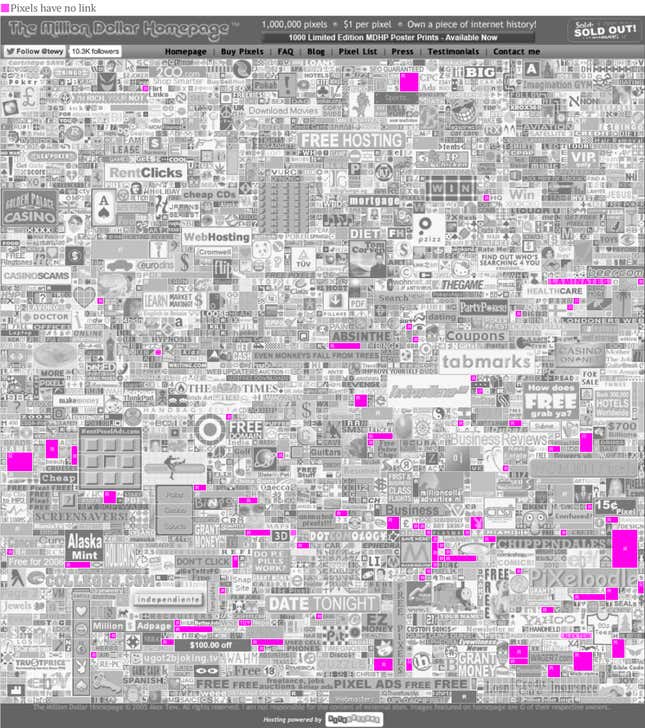Before Kickstarter and Indiegogo made crowdfunding projects simple for everyone, Alex Tew financed his college education by selling 10-by-10 pixel chunks of a webpage for $100 each. The Million Dollar Homepage became a viral sensation and sold out in 138 days.
Eight years later, the site still exists, essentially frozen in time. That provides an interesting window into the phenomenon of “link rot,” or hyperlinks that used to work but now point to dead pages. Our analysis found that 22% of the Million Dollar Homepage’s pixels now fail to load a webpage when clicked.
In the GIF below, the pink areas are now dead:
These non-functioning links account for 221,900 of the million pixels—$221,900 worth of real estate, assuming the pixels have kept their value in the last eight years.
The atrophy of links has been shown to stabilize over time, meaning we should expect fewer than 22% of links to break over the next eight years. The longer a link continues to work on a webpage, the longer it can been expected to work into the future.
Nonetheless, it remains a problem for thought experiments and seminal works alike. Researchers at Harvard found that at least 50% of URL-based legal citations in US Supreme Court opinions, for instance, no longer point to the originally referenced material.
Link rot was identified as a problem early in the development of the web. In 1998, the creator of the web—Tim Berners-Lee—noticed more and more of his bookmarked websites no longer lead to where they used to. He was compelled to instruct that cool URLs don’t change and rebutted common refrains on why sometimes they had to evolve.
One reason he did not cite: websites going offline entirely. Some domains like lowcostlogo.com, cash-advance-express.biz, and ten-best-credit-cards.com, which bought pixels on the Million Dollar Homepage, didn’t just change how their URLs worked: They simply don’t exist any longer.
Other buyers of pixels never provided a URL, and their pixels remain “reserved,” leading to 23,200 unlinked pixels currently on the site. In an email, Tew said he has never thought about reselling dead spots, but added ”perhaps I should.”

To analyze the Million Dollar Homepage, Quartz used software to load every page linked from the site. If the page did not load or took longer than 10 seconds to load, it was marked as no longer functioning.
There, of course, have been imitators to Tew’s dollar-per-pixel innovation. Some of them even bought pixels on his site. But few of them are still accessible.
Thanks to Matt Haughey for inspiring this story.